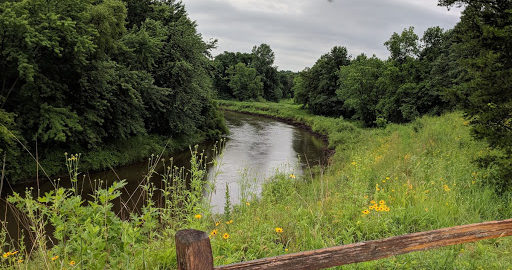The Rum River will not yield its lost-golf course secrets easily.
There are seven golf courses on or very near the banks of the Rum on its serpentine, 158-mile journey from Mille Lacs Lake in Onamia to the Mississippi River in Anoka.
Roll call: Stones Throw in Milaca, Princeton Golf Course and Rum River Hills in Anoka.
Yes, that’s only three. I can count, OK?
Completed roll call, including lost golf courses: Milaca Golf Club, Mille Lacs Golf Club in Foreston, Princeton Golf Club and Bar L Ranch Club near Isanti.
I visited the first three of those lost courses, all dating to the late 1920s or early 1930s, one day in mid-July. I had come across information on the courses in newspaper archives and with the help of local historical societies, but my day trip up Highway 169 unfortunately provided little clarity and, literally, a lot of the opposite in the form of three forced pull-overs to wait out thunderstorms.
First stop: Princeton, covered in this post. I will get to Foreston and Milaca later as I reach the 200 mark in Minnesota’s lost-golf course roll call.
PRINCETON GOLF CLUB — DOUBLED DOWN
Organized golf in Princeton started not on the Rum River but on a site one mile due west of where the river forks into its East (main) and West branches.
“Princeton Golf Club Is Organized,” read a headline in the June 21, 1928, issue of the Princeton Union. The club had 16 members and 10 who were listed as organizers of the club, with C.L. Torgerson elected the first president. “Most of the members of the club have been playing for the past month at the fair grounds where they have been laying out a course of six holes.”
The article concluded, “If interest in the game continues, next year the club plans to secure a tract of about 30 acres and lay out a larger course.”
For the sake of lost-course accounting, I’m calling this fairgrounds site Princeton Golf Club I, lost course No. 198.
Princeton Golf Club continued to operate at the fairgrounds in 1929, increasing its membership fee by $2 to $5 while considering three potential sites for relocation and expansion — one north of town, one west of the fairgrounds and one southwest of town.
The club adopted articles of incorporation on Nov. 1, 1929, shortly after it had settled on an entirely different site for expansion.
“It seems quite probable,” the Princeton Union reported in October 1929, “that negotiations will be commenced to secure the 40-acre tract owned by Joe Leathers lying east of the Scenic highway and north of the bridge over the East branch of the Rum river. The cost of purchasing this tract and improving it would be approximately $4,000.”
The next spring, the St. Cloud Times reported that the Leathers tract “will be supplemented by 20 acres leased from Charles Umberhofer on the east bank of the river, and will offer golfers here a pleasant diversion during the summer months.” Earlier, the Princeton Union reported that the course would consist of nine holes at 3,032 yards with a par of 34.
This was the genesis of what I’m dubbing Princeton Golf Club II (lost course No. 199). And, 88 years later, this was the start of the Rum twisting me this way and that, daring me — and others — to figure out exactly where PGCII was.
Here is the tale of the serpentine search:
The relocated Princeton Golf Club course, it was reported at its founding, would be mostly on or near the west bank of the Rum. Leathers’ house, which still stands, was just north of the fork in the river, near the west bank, not far from the corner of 5th Avenue North and North 5th Street. And the home of Charles “Umberhofer” — it took some digging just to determine his name actually was Umbehocker, and he had owned a prominent ice-making business on the Rum — was just south of the river’s fork, on the west bank, a site now occupied by the Princeton Community Library and apartment buildings.
My hypothesis at that point was that the golf course had lain just north of the intersection of Minnesota 95 and Rum River Road, near the homes of both Leathers and Umbehocker.
Double bogey.
Umbehocker, I was told by a Princeton native in his 90s, owned multiple plots in and around Princeton. So the golf course wasn’t necessarily near his former home. And the Leathers family, I discovered after hitting repeated dead ends in searching for informative plat maps, owned not one but two adjacent 40-acre plots, stretching from Joseph Leathers’ home north to about 12th Street. Both of those lots included land alongside the Rum, near the area of what is now Pioneer Park.
One or two people I conversed with thought the Princeton Golf Club course started near the current Princeton Middle School. Another, Wendy Davis of Princeton, who contributed immensely to the research on Princeton GC via the Mille Lacs County Historical Society, said her mother believed the golf course was in the area of Pioneer Park.
One newspaper story offered a retro-virtual layout. “The first fairway extends a distance of 485 yards and has been cleared of stumps and the land levelled with a tractor and roller,” the St. Cloud Times reported in April 1930. “The first tee will be on the hill near the city limits. In the stretch of land which as been cleared for this fairway about 100 trees were cut down and the stumps blasted out. The first green is 30 yards west of the river. Near this first green will be the second tee. The third tee will be at the south point of this high ground between a morass and the river. The fairway here, the shortest on the course will extend 170 yards northeast. There are five holes on the west side of the river and four on the east side. Foot bridges will be built to accommodate the players. The Princeton club now has a membership of 29 and 20 others are expected to join before the season is formally opened.”
All such detail provided no certainty. Plat maps and Google searches revealed nothing definitive about Princeton Golf Club’s location. I studied an aerial photo from 1939 until my right eye was my left and my left was my right but still could not positively identify the golf course.
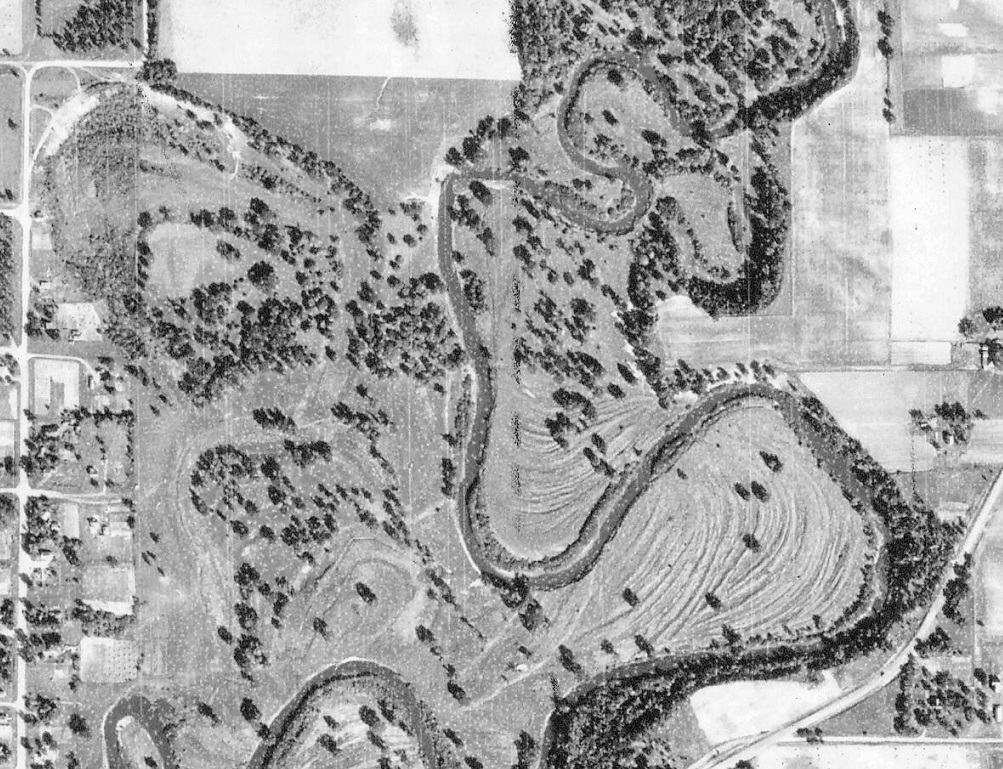
Semi-armed with information, I connected with Mike Trunk, who operates a surveying business in Princeton. Trunk once lived near the Princeton maintenance grounds on North 11th Street and had tromped on down to the Rum often as a youth to fish or just explore. He recalled from about 25 years earlier part of a structure near a sharp bend in the river that he thought might have been a footbridge. Was it for the golf course? We didn’t know but suspected it was. So, parking at Princeton Middle School, Trunk and I tromped down to the river again, him smartly wearing above-the-ankle rubber boots and me stupidly wearing shorts and tennis shoes. (I got wet feet but avoided the poison ivy, thanks only to Trunk’s direction.)
There, we found …
… nothing, really, but the Rum, plus high grass and dozens of wooden footings that Trunk speculated had been pounded into the riverbank in recent years to support the ground just below the middle school. He also speculated that remnants of the suspected footbridge might have been removed at the same time.
There was no tangible evidence of a golf course having occupied the land, though we knew it almost certainly did.
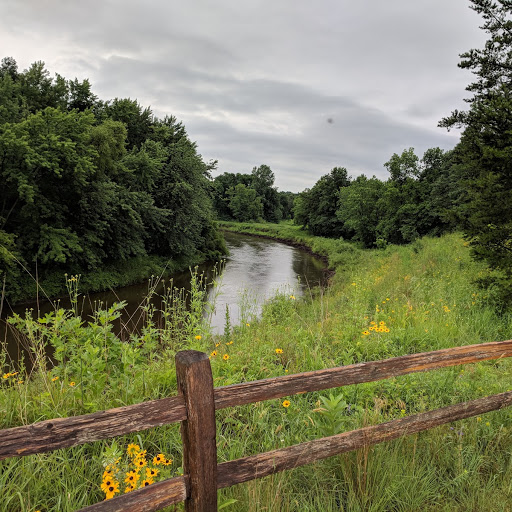
I briefly walked through part of Pioneer Park, again concluding nothing except that the area likely had changed dramatically since the 1930s, the open areas largely filling in with woods and backwater.
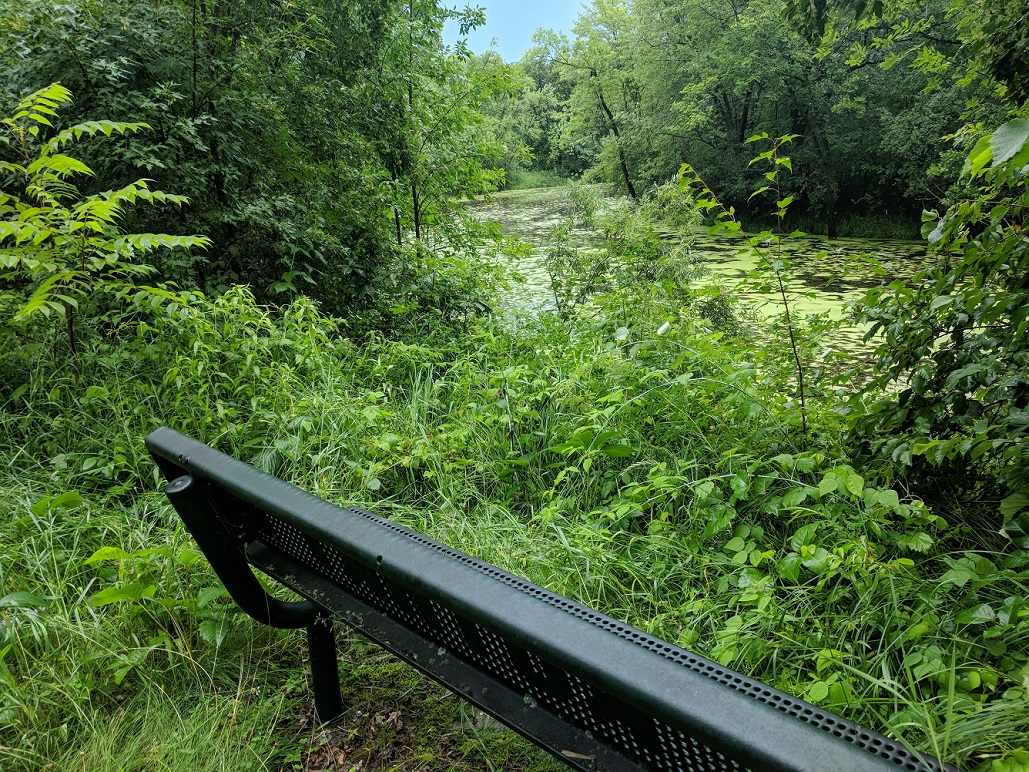
POST-SEARCH
The Rum still has me hornswoggled. It did not invite me to search further that day, instead summoning partner-in-crime Mother Nature to chase me out of the area with a nasty thunderstorm (shown below, near the Leathers house).
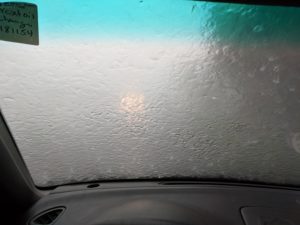
I now concede to the Rum and am willing to offer only a best guess on the exact whereabouts of Princeton Golf Club II:
I believe the first tee was near the northeast corner of the maintenance grounds, and the first hole was a dogleg right that skirted what is now the middle school grounds and finished near the river. I would say the second and third holes also were on the west side of the river. After a river crossing, holes 4, 5, 6 and 7 were on the east side. The eighth was back on the west side, and the ninth ran parallel to the eighth, returning and ending near the first tee. A river crossing on one or two of the holes would have made sense from a golf-design standpoint, but I can’t speculate on candidates for that.
Trunk, I gather, believes the course might have been slightly north of where I judge it to have been. I don’t think either of our theories is more or less valid than the other.
There are other elements of certainty about Princeton Golf Club’s Rum River site. Well, relative certainty.
As the new grounds opened in 1930, E.L. McMillan was club president. The next year brought a new president, Raleigh Herdliska. In April 1932, the Princeton Union reported that a family membership would cost $15, with no one under the age of 12 allowed on the course. Greens fees would be 35 cents, 50 cents for Sundays and holidays. The club manager, W.C. Roos, was enlisted to “remove the danger of lost balls in the right rough at the right of the first fairway.” In May 1932, plans were announced for a tournament to be held.
By 1934, Princeton High School was fielding a golf team, presumably with a hat tip to Princeton GC for having established the game in town. Also in 1934, a shortstop tournament attracted 23 entries. (Update, 2019: Another 1934 story, passed along in late 2018 by Wendy Davis, reported that the golf course had been leased to the village of Princeton for five years.)
Details in a 1935 Princeton Union story contradicted earlier reports, asserting that a course of 1,700 yards was laid out in 1929 and that “700 more yards were added last summer.”
“The links are in a beautiful location,” the story continued, “and the course will undoubtedly in future years become popular. Just as present the links are not in particularly good condition but William Roos who is the manager states he expects to have them ready for the players by July 4.”
Contrary to the story’s speculation, Princeton Golf Club’s grounds likely were soon abandoned. A 1938 Union story reported on a meeting at which it was “decided that an effort should be made to revive the Princeton Golf club. Eight members were in attendance.” F.J. Maroney operated the club and held the lease at that time. (I could not find on plat maps any nearby land owned by Maroney around that time.)
I found no further references to the golf club in 1938 or 1939, leading me to conclude the course remained closed even after the “revival” meeting. Years later, in August 1954, the St. Cloud Times reported on the formal opening of a new course, Rum River Golf Club, on the southeastern side of town and again alongside the river. That layout remains in operation today as Princeton Golf Course.
Postscript: After this post was published, I was apprised of 1937 Union stories reporting that Maroney, “athletic coach of the Princeton school,” had leased the golf course grounds and planned on repairing them and reopening the course after two years of it lying idle. A tournament was played there in June.
ONE LAST PUZZLE
There are conflicting and puzzling reports on the designer of Princeton Golf Club at the Rum River site.
The October 1929 Union story on the club reported that a group including “J.A. Hunter, a professional golf player of Minneapolis, inspected the grounds. Mr. McMillan stated Mr. Hunter thought the tract would make an ideal course.
“Mr. Hunter has considerable experience in laying out golf courses. He is at present working on a course at Nicollet and Lyndale in Minneapolis, and has planned and rearranged several other courses in that city. He agreed to come to Princeton at different times for a nominal consideration to direct the work of laying out the golf course.”
In March 1930, however, the Union reported that Charles J. Mulder would lay out the new course and that Mulder “has laid out some of the finest golf courses in the Twin Cities.”
I have not heard of a Charles Mulder in relation to Minnesota golf. Research turned up a Charles Mulder who lived in nearby Zimmerman, with a suggestion that he had experience in earth-moving. Perhaps Hunter — James A. Hunter, who in 1923 designed the nine-hole Country Club, a layout that would become known as Edina Country Club — handled the Princeton GC routing and other details, while Mulder presided over construction.
As for the reference to Hunter working on a course at “Nicollet and Lyndale,” that is as baffling as anything in this story. Those streets run parallel through Minneapolis, just blocks apart, and there is no current or lost course in that area of the city.
Next: Mille Lacs Golf Club at Foreston, Minnesota lost golf course No. 200.
Latest posts by Joe Bissen (see all)
- Another lost routing: Hilltop, Columbia Heights - June 19, 2024
- Two lost routes: First, Antlers Park - June 17, 2024
- Tree trouble and townball: Naeseth Country Club, Wanamingo - May 6, 2024
